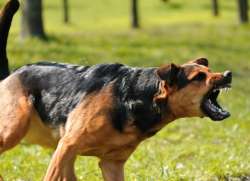This hormone might be the reason behind aggressiveness of your dog
Dog aggression is a huge problem. Thousands of people are hospitalised every year for dog bites.

Is your dog too aggressive? Besides barking and growling randomly, do they become fierce on seeing another canine walking by? A new research proves that oxytocin and vasopressin are responsible for this. These hormones which are also found in humans are to be blamed for dogs' behaviour.
Dogs that reacted aggressively showed higher levels of total vasopressin in their systems, suggesting a link between vasopressin and aggression.Similarly, oxytocin was found to help inhibit aggression in the dogs, the researchers said.
"Dog aggression is a huge problem. Thousands of people are hospitalised every year for dog bites, especially kids, and aggression is one of the main reasons that dogs get relinquished to shelters," said Evan MacLean, assistant professor at the University of Arizona."It would be reasonable to think that if vasopressin facilitates aggression, you could develop pharmaceuticals that could target the vasopressin system to help in cases where dogs are really aggressive."
Better understanding the biology behind canine aggression could help with the development of interventions, the researchers said. For the study, published in the journal Frontiers in Psychology, the team recruited pet dogs of varying ages, breeds and sexes, whose owners reported struggles with leash aggression. Further, when oxytocin levels of the pet dogs in the study were compared to a group of assistance dogs, which are specifically bred to have non-aggressive temperaments, the researchers found that the assistance dogs had higher levels of oxytocin and higher oxytocin-to-vasopressin ratios. This supports the idea that oxytocin may help inhibit aggression in dogs.
The research also found that such behaviour in dogs is also result of some kind of trauma. For example- if the dog has been tortured or attacked by other dogs, there are chances of aggression in its behaviour.
(With IANS inputs)